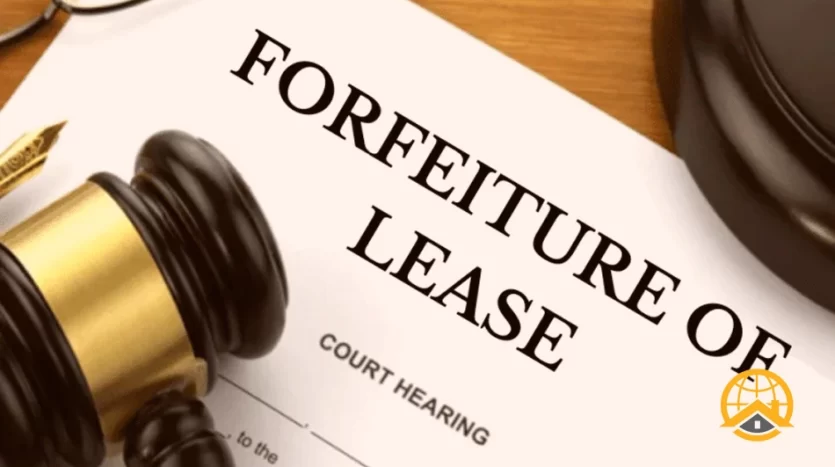What is Landlord Forfeiture of Lease, And How Does it Work?
Forfeiture meaning is giving up something as a penalty. The forfeiture of lease is a powerful legal tool that allows landlords to regain possession of a property when a tenant breaches their lease agreement.
This action can be taken for various reasons, such as non-payment of rent or a breach of agreement, but it requires careful legal steps to be valid. Understanding how forfeiture of lease works and what defences are available is crucial for landlords and tenants to protect their rights. So, start reading to explore everything you need to know about forfeiture of lease;
What is Forfeiture of Lease?
Forfeiture of lease is the process through which a landlord can terminate a tenant’s lease due to violating the lease terms. The landlord can exercise this legal right when certain conditions, typically specified in the lease, are breached.
Forfeiture of the lease is a contractual right of commercial landlords under the Landlord and Tenant Act 1954.
Legal Background of Forfeiture of Lease
According to the Property Act 1925, the foundation of forfeiture should be considered unchangeable before law and enforcement are involved, and the forfeiture of the lease is implemented. There are the three most common reasons for breaching forfeiture;
Breach of Agreement
Suppose the tenants are involved in illegal activities, misuse the property, or fail to maintain it according to the agreement. In that case, the landlord can instantly forfeit the lease.
Non-Payment of Rent
If the tenants fail to pay the rent on time or under a set tenure, the landlord has the right to initiate the forfeiture of the lease.
Disruptive Tenants
If the tenants are producing too much noise and waste in your commercial property area, a landlord has the right to initiate the forfeiture of the lease. If the landlord doesn’t do so, it might be difficult for him to rent his property
further and maintain it.
Remember, the rules and regulations for the forfeiture of commercial leases differ from those of residential properties. So, the forfeiting process will be different for both scenarios.
What is the Process of Forfeiture of Lease?
1: Issuing the Section 146 Notice
The first and foremost step of forfeit is issuing the section 146 notice. Don’t you know about the notice for section 146? If yes, let’s discuss it first;
Section 146 Notice: It is a legal notice served to the tenants with proper details of all breaches, allowing them to explain them reasonably to the landlord.
For instance, if a tenant has rented out the property further without informing the landlord, a Section 146 notice allows the tenant to explain the breach scenario to the landlord. So, the matter can be solved before legal action can be taken against the tenants.
2: Peaceable Re-Entry of Landlord
According to peaceable re-entry, a landlord has the right to re-enter the rental property with the forfeit of the lease. However, the re-entry should be peaceful according to regional rules and compliances.
This re-entry doesn’t involve court or any other legal action. A landlord can simply take back the property from the tenants if they breach any point of the legal agreement. However, landlords can do it only when the rental property is unoccupied.
3: Court Intervention
If the tenants don’t leave the property peacefully, even after breaching the legal agreement and don’t answer the section 146 notice issue, landlords might involve the court. Court proceedings will take longer than issuing a section 146 notice and peaceable re-entry.
The court will review both side’s evidence, including the landlord and tenants. If the tenants have served the Section 146 notice and changed the breach, the court might grant them relief.
Similarly, if tenants didn’t serve and consider the section 146 notice, the landlord will get back their property even before the end of the lease tenure.

How Can Tenants Defend Themselves Against Forfeiture?
Here are a few ways tenants can consider to defend themselves against forfeiture of commercial lease;
Apply for Relief from Forfeiture
Tenants can also apply in court for relief from forfeiture. However, this court proceeding or appeal is beneficial only if they pay the rent due or solve the legal breaches charged by landlords.
Challenge the Improper Serving of Section 146 Notice
Tenants can also challenge landlords for improperly serving Section 146 notices or inappropriately charging legal breaches. They can also challenge the landlord in court if he has yet to follow the legal process of forfeiture of the lease.
By considering these preventive or defensive mechanisms, tenants can protect their lease until it ends and avoid sudden eviction.
Seek for Legal Assistance
If you want to defend yourself successfully, whether as a landlord or tenant, against forfeit, professional and legal assistance can play a crucial role. If you are in the UK and looking for legal aid to counter the forfeit of the lease, contact Home World Management.
Tenants and landlords can both rely on HWM to safeguard their rights against forfeiture without any consequences.
What are the Financial Consequences of Forfeiture of Lease?
Consequences of Forfeiture for Tenants
Undoubtedly, forfeiture might lead to severe consequences for the tenants regarding lease loss. If it is commercial forfeiture of a lease, it might substantially impact the tenant’s business.
Additionally, tenants may experience a financial crisis and pay legal fees after the lease is forfeited. A forfeiture might affect a tenant's worthiness, and he might find it challenging to win a lease in the future.
Consequences of Forfeiture for Landlords
Breach of the lease by the freeholder or landlords also affects their reputation in the real estate market. Forfeiture is a costly and time-consuming process. If the property remains unleased after forfeiture, the landlords might lose income.
On the other hand, if the landlords fail to prove their stance, they might face counterclaims from tenants.
What are the Best Ways to Avoid Forfeiture of Leases?
Set Up Payment Plans with Landlords
If tenants have difficulty paying the rent on time, they can set up payment plans with the landlords. Under these plans, landlords and tenants could agree upon the exact date and time for rental payments.
Negotiation Before Forfeiture
Landlords and tenants can negotiate with one another to solve the issues with mutual understanding before proceeding with the forfeiture of the lease. This way, both parties can save themselves from legal proceedings and costs.
Best Practices to Follow for Landlords
- Keep a track record of all legal breaches and matters in written format.
- Always prepare and issue the legal notice, especially section 146, appropriately.
- Communicate with tenants healthily to solve matters without involving law and enforcement.
Can a Landlord Forfeit a Lease Illegally?
So, it would be best for the landlords to follow the proper forfeiture of lease method and let the tenants justify the legal infringement before re-occupying the property.
In conclusion, forfeiture is crucial for landlords and tenants. With a proper understanding of the legal process and its steps, tenants and landlords can counter the situation appropriately.
Whether you are a landlord or a tenant, read this guide to understand each aspect, forfeit processing and best practices to avoid these legal proceedings.
Note:
Remember, a landlord can forfeit only if he has included the right to forfeiture of the lease in the tenancy agreement. Commercial leases can be forfeited only if there is no residential element.
Even the partial involvement of residential property couldn’t allow the landlord to forfeit the lease. The forfeiture rules of the lease for residential properties differ from those for commercial properties.
If any tenant’s belongings are inside the forfeited property, tenants can recover those goods according to the Torts Interference Goods Act 1977.





